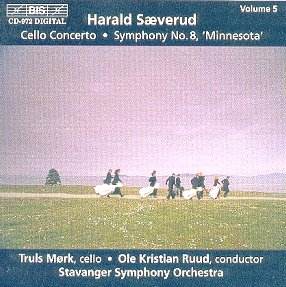Harald SAEVERUD
Cello Concerto; Symphony
No.8
 Truls Mork (cello)/Stavanger Symphony Orchestra/Ole Kristian
Ruud
Truls Mork (cello)/Stavanger Symphony Orchestra/Ole Kristian
Ruud
 BIS CD-972 [64'
21"]
BIS CD-972 [64'
21"]
Crotchet

Bergen-born Saeverud (1897-1992) saw musical life from different angles.
As a conductor he worked with Clemens Krauss, and for a decade or so was
a music critic (good for him!). First and foremost he was a composer - a
very self-critical one. Not for the first time Robert Ronnes (a fellow Norwegian
composer close to Saeverud) has realised music that proved troublesome to
its composer. Saeverud started his Cello Concerto in 1930, revised it in
the 'fifties, but its final form remained elusive. Seventy years on, a first
performance and recording!
This CD is Volume 5 of BIS's Saeverud series. An English counterpart to him
would be Edmund Rubbra. Those who appreciate Rubbra's formal mastery and
spiritual aspirations should certainly respond to Saeverud. Melody is the
root of Saeverud's invention; his expression is personal and communicative
and requires concurrent appreciation of its organic development and emotional
release. The Concerto - superbly played by Mork - has an unlikely beginning,
a clarinet cadenza imitating a jazz break! Saeverud's musical ideas serve
and extend tightly organised structures in which the soloist is integrated
with a smallish orchestra dialoguing rhythmic cells and interweaving colours.
The music's emotional core comes into its own in the plaintive slow movement.
Fine music that invites further playing.
The Symphony, sub-titled "Minnesota", was composed in 1958 for the state's
centenary. Antal Dorati premiered it with the Minneapolis Orchestra. While
the Concerto emerges as a satisfying entity (now), Saeverud's penultimate
Symphony is uneven (yes, Saeverud's another nine-symphony composer!). At
40 minutes it's an ambitious work, full of fine things, but it lacks symphonic
direction. I wonder if Saeverud was distracted by the reason for the commission
(he kept a map of Minnesota above his desk during composition)? The first
movement `Once upon a time…' grows from nothing to suggest great industry.
Despite vital rhythms and colourful orchestration I feel Saeverud is more
concerned with imagery than musical argument. But the slow movement is another
matter. My experience of Saeverud to date suggests him as primarily a composer
of abstract music requiring intelligent listening. He certainly has a heart
(and wit) though, and his ability to characterise is achieved economically
and imaginatively. So, the 8th Symphony's `Hope and longing' movement is
especially beautiful, an ever-evolving melody, nostalgic and melancholy,
autumnal-coloured (with a suggestion of Copland's Appalachian Spring at the
opening). Arching and sighing, this music's shapely contours quietly stab
the heart.
What follows is a delightful, somewhat corny movement that is more concerned
with local colour - people and animals living an untroubled life in a rural
setting - that relies on instrumental effect and village-hall waltz. The
Finale is the percussive movement `Man and the machine' might suggest; though
there's some troubled lyricism - suggestive of `man versus machine' perhaps
- along the way.
Excellent performances complemented by outstanding sound. Anyone new to Saeverud
should try first his music for Peer Gynt
[BIS-CD-762]
and the Violin Concerto coupled with Symphony 3
[BIS-CD-872]…
then make room for more! Those that already know this fine composer's music
will, I imagine, not be hesitating. For the symphony's slow movement alone
this CD is recommended.
Reviewer
Colin Anderson
